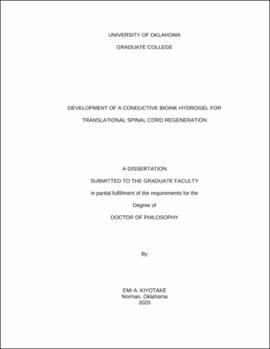| dc.description.abstract | Spinal cord injury (SCI) patients rarely recover full functionality with current clinical treatments. There are two approaches for developing treatments for SCI: 1) rehabilitation strategies and 2) regenerative medicine strategies. Individually, each strategy has not been able to facilitate full functional recovery after severe SCI. Rehabilitation strategies have shown better functional recovery compared to regenerative medicine approaches, especially when motor training was combined with electrical stimulation (ES) for patients with incomplete SCIs. However, patients with more severe injuries may not recover full functionality from only rehabilitation approaches. As discussed in the SCI literature, there is a need to combine the fields of rehabilitation and regenerative medicine to maximize functional recovery, but there are not many methods to synergistically combine the fields. Conductive biomaterials may be the missing link that enables synergistic combination of regenerative medicine with the rehabilitation approach of ES. Unfortunately, there are a paucity of in vivo studies using conductive biomaterials for SCI. One problem is that most conductive biomaterials are preformed scaffolds that are risky and challenging to implant in an SCI, which does not have defined borders. However, an injectable biomaterial may be easier to deliver into the most common contusion SCI than a preformed scaffold and thus, may be more translational. Given that the bioprinting field focuses on several of the same parameters used in developing injectable biomaterials, that field may offer insight in designing injectable materials. In the current dissertation, an existing fast-crosslinking pentenoate-functionalized hyaluronic acid (PHA) hydrogel precursor was first developed into a bioink and the rheology of the bioink was characterized to predict printability. The PHA bioink was then developed to be adhesive for rat neural stem cells (rNSCs) through the incorporation of a newly developed pentenoate-functionalized gelatin (PGel) based on the same chemistry employed for PHA. The rheology of the adhesive formulations of the PHA/PGel bioink were characterized to determine the printable formulations. Finally, a conductive and injectable/bioprintable hydrogel was developed by incorporating gold nanorods (GNRs) into PHA/PGel, and was subsequently applied to a thoracic level (T8) lateral hemi-section rat spinal cord injury (SCI) model. While no significant differences in functional recovery or axon regeneration were found across any of the tested material groups, the feasibility of the injectable/paste-like GNR hydrogel precursors and the long-term safety of the crosslinked hydrogels were demonstrated. No previous studies have applied a GNR-based conductive hydrogel to SCI, therefore, the significance of the current dissertation was the development of a conductive biomaterial that was a bioprintable/translational platform for contusion SCIs. The GNR hydrogel may be further refined with the addition of other regenerative medicine approaches to promote axon regeneration and synergistically combined with rehabilitative approaches, such as ES, to facilitate full functional recovery after SCI. | en_US |
